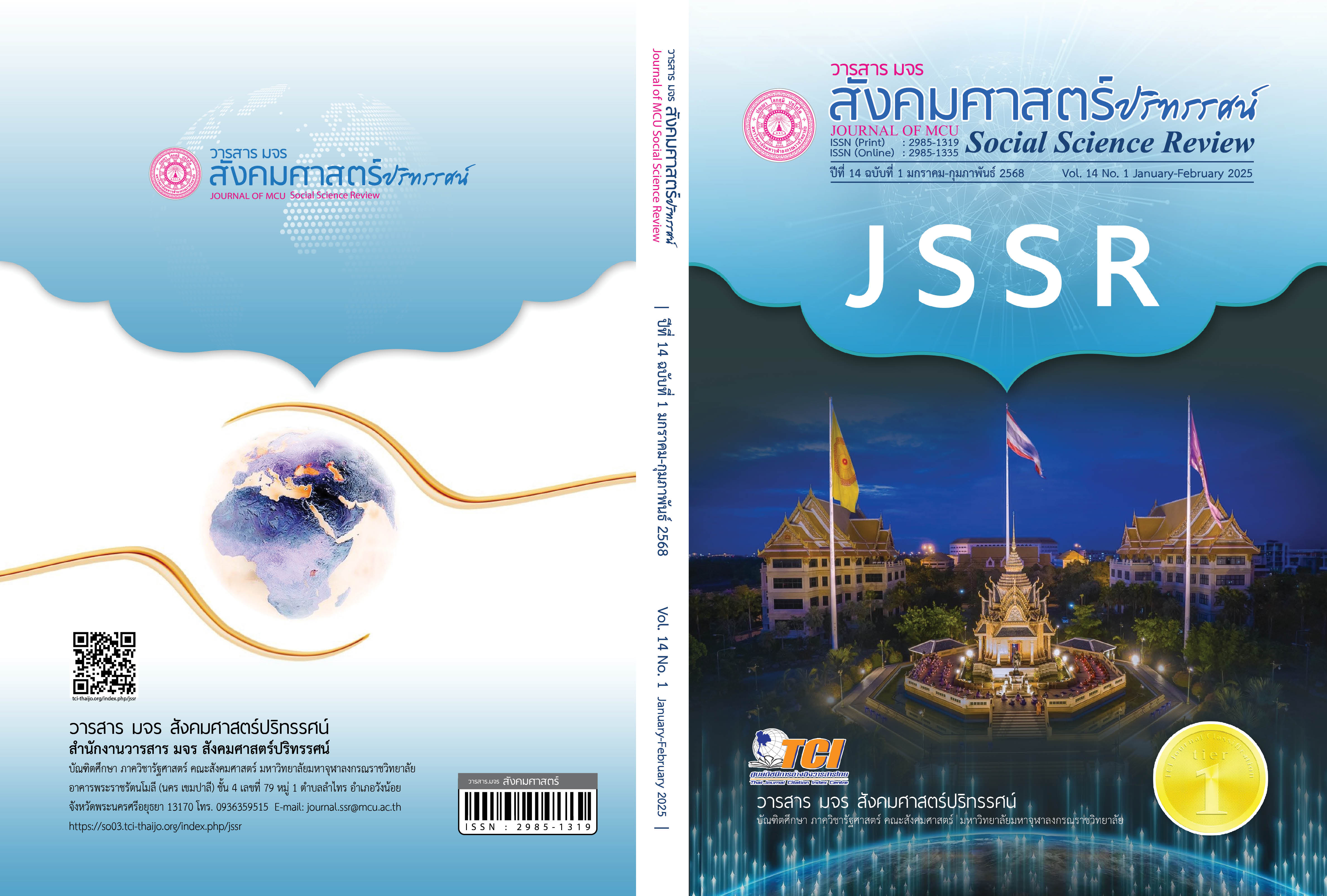จิตวิญญาณความเป็นครูของนักศึกษาคณะครุศาสตร์ มหาวิทยาลัยราชภัฏบุรีรัมย์
คำสำคัญ:
จิตวิญญาณความเป็นครู, นักศึกษาคณะครุศาสตร์, มหาวิทยาลัยราชภัฏบุรีรัมย์บทคัดย่อ
บทความวิจัยครั้งนี้มีวัตถุประสงค์ 1. ศึกษาระดับจิตวิญญาณความเป็นครูของนักศึกษา2. เปรียบเทียบจิตวิญญาณความเป็นครูของนักศึกษาที่จำแนกตามเพศ ระดับชั้นปี และสาขาวิชา และ 3. วิเคราะความสัมพันธ์ระหว่างจิตวิญญาณความเป็นครูกับเกรดเฉลี่ยรวม และแรงจูงใจใฝ่สัมฤทธิ์ในการเรียน งานวิจัยนี้ใช้ระเบียบวิธีการวิจัยเชิงปริมาณ กลุ่มตัวอย่างคือ นักศึกษาชั้นปีที่ 1 ถึง 5 ของคณะครุศาสตร์ มหาวิทยาลัยราชภัฏบุรีรัมย์ ประจำปีการศึกษา 2567 จำนวน 346 คน ซึ่งได้มาจากการสุ่มแบบแบ่งชั้นตามสาขาวิชา เครื่องมือวิจัยเป็นแบบสอบถามที่มีค่าความเชื่อมั่น (ค่าสัมประสิทธิ์แอลฟาครอนบาค) เท่ากับ 0.968 การวิเคราะห์ข้อมูลใช้สถิติบรรยาย ได้แก่ ความถี่ ร้อยละ ค่าเฉลี่ย และส่วนเบี่ยงเบนมาตรฐาน และสถิติอ้างอิง ได้แก่ การทดสอบค่าที การวิเคราะห์ความแปรปรวนทางเดียว และการวิเคราะห์
ค่าสหสัมพันธ์เพียร์สัน
ผลการวิจัยพบว่า 1. ระดับจิตวิญญาณความเป็นครูของนักศึกษาโดยรวมอยู่ในระดับสูงที่สุด และในรายด้านอยู่ในระดับสูงถึงสูงที่สุด 2. จิตวิญญาณความเป็นครูมีความแตกต่างอย่างมีนัยสำคัญทางสถิติที่ระดับ .05 ตามระดับชั้นปีและสาขาวิชา แต่ไม่มีความแตกต่างตามเพศ และ 3. ความสัมพันธ์ระหว่างจิตวิญญาณความเป็นครูกับแรงจูงใจใฝ่สัมฤทธิ์ในการเรียนมีความสัมพันธ์ทางบวกระดับแข็งแกร่ง อย่างมีนัยสำคัญทางสถิติที่ระดับ .01 แต่ไม่มีความสัมพันธ์กับเกรดเฉลี่ยรวม
เอกสารอ้างอิง
กิตติชัย สุธาสิโนบล. (2564). ครูมืออาชีพ : จิตวิญญาณแห่งศาสตร์และศิลป์ของความเป็นครู.กรุงเทพฯ: คอมเมอร์เซียล เวิลด์ มีเดีย.
คณะครุศาสตร์ มหาวิทยาลัยราชภัฏบุรีรัมย์. (2567). วิสัยทัศน์ พันธกิจของคณะครุศาสตร์. สืบค้น14 พฤศจิกายน 2567, จาก https://edu.bru.ac.th/about/general/
ดวงใจ ชนะสิทธ์ และพงศ์เทพ จิระโร. (2562). ปัจจัยเชิงสาเหตุของการส่งเสริมจิตวิญญาณความเป็นครูของนักศึกษาคณะครุศาสตร์ มหาวิทยาลัยราชภัฏภูมิภาคตะวันตก. วารสารศิลปากรศึกษาศาสตร์วิจัย, 11(1), 290-309.
ไทยรีฟอร์ม. (2556). เปิด 6 อุปสรรคการทำงานของครูไทย. สืบค้น 14 พฤศจิกายน 2567, จาก https://www.isranews.org/content-page/item/18823
ธรรมนันทิกา แจ้งสว่าง. (2554). ประสบการณ์ของครูผู้มีจิตวิญญาณความเป็นครู : การศึกษาเชิงปรากฏการ์วิทยา. วารสารพฤติกรรมศาสตร์, 18(1), 55-56.
นิวัตต์ น้อยมณี. (2551). ผมคิดและเชื่ออย่างนี้. กรุงเทพฯ: จามจุรีโปรดักท์.
_____. (2560). จิตวิญญาณครู. นนทบุรี: 21 เซ็นจูรี่.
มหาวิทยาลัยราชภัฏจันทรเกษม. (2566). Professional Teacher Rajabhat University Model หลักสูตรผลิตครูฐานสมรรถนะ มหาวิทยาลัยราชภัฏ. กรุงเทพฯ: มหาวิทยาลัยราชภัฏจันทรเกษม.
มหาวิทยาลัยราชภัฏบุรีรัมย์. (2567). ประกาศมหาวิทยาลัยราชภัฏบุรีรัมย์ เรื่อง การรับสมัครนักศึกษาเข้าศึกษาต่อในระดับปริญญาตรี รอบที่ 2 รับตรง (เพิ่มเติม) ประจำปีการศึกษา 2568. บุรีรัมย์: มหาวิทยาลัยราชภัฏบุรีรัมย์.
_____. (2567). แผนปฏิบัติการประจำปีงบประมาณ พ.ศ. 2567 มหาวิทยาลัยราชภัฏบุรีรัมย์. บุรีรัมย์: มหาวิทยาลัยราชภัฏบุรีรัมย์.
มหาวิทยาลัยราชภัฏวไลยอลงกรณ์ ในพระบรมราชูปถัมภ์. (2567). การผลิตบัณฑิตครูตามกรอบ PTRU Model. ปทุมธานี: มหาวิทยาลัยราชภัฏวไลยอลงกรณ์ ในพระบรมราชูปถัมภ์.
รุ้งลาวัณย์ จันทรัตนา. (2566). คุณลักษณะสำคัญและรูปแบบการพัฒนาคุณลักษณะครู นักพัฒนา. วารสารมหาวิทยาลัยราชภัฏยะลา, 18(2), 131-141.
สจีวรรณ ทรรพวสุ. (2560). กลยุทธ์การพัฒนาจิตวิญญาณความเป็นครูเพื่อส่งเสริมความเป็นครูวิชาชีพของนักศึกษา คณะครุศาสตร์ มหาวิทยาลัยราชภัฏสวนสุนันทา. วารสารราชพฤกษ์, 15(1), 1-10.
สมบัติ คชสิทธิ์ และอรสา จรูญธรรม. (2565). จิตวิญญาณความเป็นครูของนักศึกษาคณะครุศาสตร์ มหาวิทยาลัยราชภัฏวไลยอลงกรณ์ในพระบรมราชูปถัมภ์. วารสารสังคมศาสตร์และมานุษยวิทยาเชิงพุทธ, 7(6), 540-555.
สำนักงานเลขาธิการสภาการศึกษา. (2550). นานาทัศนะในการวิจัยประเมินผลคุณภาพของคนไทย: ดี เก่ง และมีความสุข. กรุงเทพฯ: วี.ที.ซี. คอมมิวนิเคชั่น.
_____. (2560). แผนการศึกษาแห่งชาติ พ.ศ. 2560-2579. กรุงเทพฯ: พริกหวานกราฟฟิค.
สำนักงานส่งเสริมสังคมแห่งการเรียนรู้และคุณภาพเยาวชน. (2557). การยกระดับครูไทยในศตวรรษที่ 21. กรุงเทพฯ: สำนักงานส่งเสริมสังคมแห่งการเรียนรู้และคุณภาพเยาวชน.
สุภาพร ชูสาย. (2566). แรงจูงใจใฝ่สัมฤทธิ์ของนักศึกษา คณะครุศาสตร์ มหาวิทยาลัยราชภัฏเพชรบูรณ์ ที่เข้าร่วมโครงการเสริมสร้างแรงจูงใจก้าวอย่างมั่นใจสู่ครูมืออาชีพ. วารสารสันติศึกษาปริทรรศน์ มจร, 11(2), 434-464.
อริศรา แก้วสุข และคณะ. (2565). การวิเคราะห์องค์ประกอบจิตวิญญาณความเป็นครูของนิสิตคณะครุศาสตร์ มหาวิทยาลัยบูรพา. วารสารพัฒนาเทคนิคศึกษา, 34(112), 44-52.
Krejcie, R. V. & Morgan, D. W. (1970). Determining Sample Size for Research Activities. Educational and Psychological Measurement, 30(3), 607-610.
ดาวน์โหลด
เผยแพร่แล้ว
รูปแบบการอ้างอิง
ฉบับ
ประเภทบทความ
สัญญาอนุญาต
ลิขสิทธิ์ (c) 2025 วารสาร มจร สังคมศาสตร์ปริทรรศน์

อนุญาตภายใต้เงื่อนไข Creative Commons Attribution-NonCommercial-NoDerivatives 4.0 International License.
เพื่อให้เป็นไปตามกฎหมายลิขสิทธิ์ ผู้นิพนธ์ทุกท่านต้องลงลายมือชื่อในแบบฟอร์มใบมอบลิขสิทธิ์บทความให้แก่วารสารฯ พร้อมกับบทความต้นฉบับที่ได้แก้ไขครั้งสุดท้าย นอกจากนี้ ผู้นิพนธ์ทุกท่านต้องยืนยันว่าบทความต้นฉบับที่ส่งมาตีพิมพ์นั้น ได้ส่งมาตีพิมพ์เฉพาะในวารสาร มจร สังคมศาสตร์ปริทรรศน์ เพียงแห่งเดียวเท่านั้น หากมีการใช้ภาพหรือตารางหรือเนื้อหาอื่นๆ ของผู้นิพนธ์อื่นที่ปรากฏในสิ่งตีพิมพ์อื่นมาแล้ว ผู้นิพนธ์ต้องขออนุญาตเจ้าของลิขสิทธิ์ก่อน พร้อมทั้งแสดงหนังสือที่ได้รับการยินยอมต่อบรรณาธิการ ก่อนที่บทความจะได้รับการตีพิมพ์ หากไม่เป็นไปตามข้อกำหนดเบื้องต้น ทางวารสารจะถอดบทความของท่านออกโดยไม่มีข้อยกเว้นใดๆ ทั้งสิ้น





